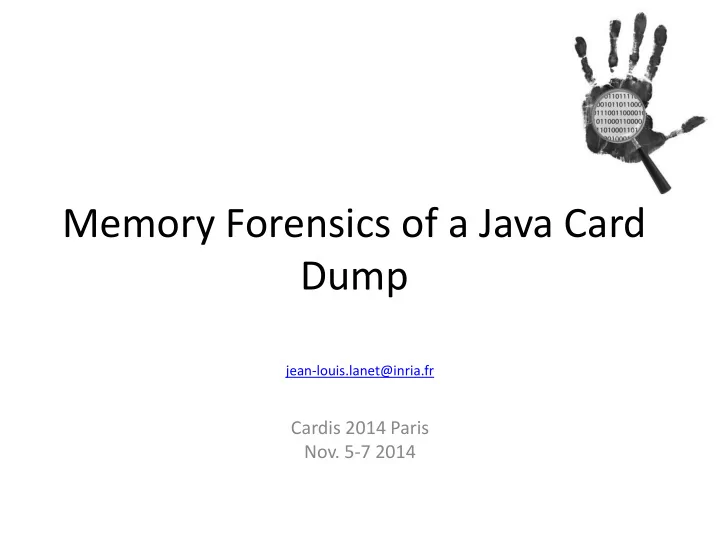

Memory Forensics of a Java Card Dump jean-louis.lanet@inria.fr Cardis 2014 Paris Nov. 5-7 2014
Episode 2 • Previous episode: how to obtain a dump • Hypothesis • Find the code • Reverse it • Conclusion
Memory Dump • At that time we have a binary file representing the memory, • Reversing is a hard task, – E2prom has no region, – Several heaps, – Several binary languages, – Unknown bye codes, – Sometime masked sometime encrypted. • Task prone to error and no tool to automatically reverse it, • The objective: obtain from the binary dump the Java source file.
From binary to source • Starting point is the dump file where somewhere is the method area, • Reversing process – Isolate the method area, – Regenerate a CAP file, – Tokenize the CAP – Use the CAP2Class tool – Use a Class2Java tool
Memory Carving • Regenerate the memory regions – Extract the Java Byte code area from the rest, – Remaining could be: • System Data, Application Data, VM Data, Native code • Usual approach brute force – Verify a legal control flow graph, – Adapted to small pieces of code, – We can not use byte code interpretation due to illegal byte code, – We need a heuristic approach.
Limit of the approach • It does not work if: – the dump refers to encrypted byte code area not obtained with the VM but using an array extension, – the encrypted code has different key for different security context if obtained by the VM using a getstatic , – the card use a dynamic xor (Razandralambo, 2012) • Works well: – Code is in plain text – Use a static xor .
Memory Carving • Forensic Memory Carving, – Using language recognition, – Java and Assembly area, – Array and Object structure • Index of coincidence – The value of IC for Java Card byte code in a CAP file is between 0.02 and 0.06
Memory Carving
Symbolic execution • Building the different CFG, • By hypothesis we do not have the *.exp file of the applet, • Identifying the beginning of each method, – Checking the stack evolution in term of type system, – Isolate the unknown instructions with their effects on the stack, • As a result a set of grouped methods with 2..4 entry points: – process , install , select , deselect , – The others are private methods plus the constructor, • ( aload_0 ; invokespecial 0 ;…) • Sometime proprietary instructions…
Reversing • At that step we have identified the different method areas, • We have to rebuilt the CAP components from the method component.
Resolve the names and rebuild • Thanks to (Hamadouche, 2012) we have the relationship between addresses and method names, – This is the way to identify register() , ifSelectingApplet() that characterize install() and process() , – It allows to define the import component and then the class component, • Rebuild the header and the applet , • Issue: – the staticField component initialization: current value or default value – the accessor of the attributes defined in the class are lost.
Finish the CAP • Some instructions in method require parameters that must be un resolve, • Generate the tokens and build the reference location and the constant pool components. • Build the descriptor component that has all the offsets of each component.
Obtain the source code • Students designed a “Partial Linked Cap to Unresolved Cap” tool, • Validated using the BCV, • Not completely automated, • But no reason to not succeed, • When packaged could be open source.
Conclusion • This engineering work has been done by students of a master degree (M1) from the University of Limoges during their Java course, • It was a 60 hours development project (5 students), around 300 hours, • Entirely written in Java, could be provided as an open source project if they want to package their work, • A good introduction to Java Card course.
Question ?
Recommend
More recommend